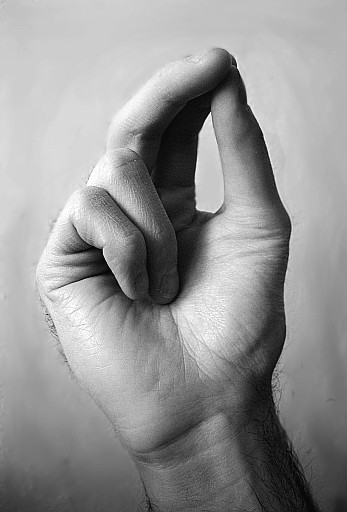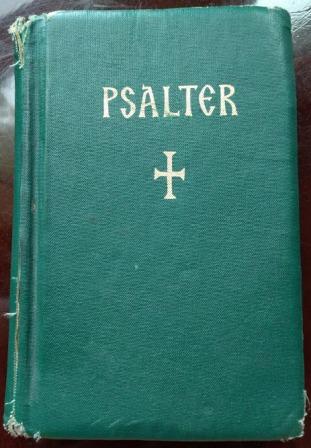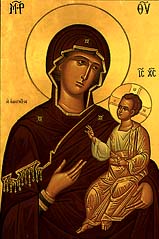BEG Questions
Tuesday, 7/19/2016
Questions about: How a priest blesses, The sign of the cross, fringe on the priests vestment, prostrations, Jesus prayer, prostrations on Sunday, common services, Psalter, stars in icons of the Theotokos.
A BEG is, basically, a scavenger hunt in the woods. This Russian word literally means run. The trail the campers will follow is littered with various objects that are visible from the trail, although they are somewhat hidden. The campers must traverse the trail, and find as many objects as possible. They do not disturb the objects, but write down their name. For instance, they might find a red stocking cap hanging from a tree limb, or a chess piece under a log.
There are also several stations where crazy stuff happens, and they must do something for points. For instance, in todays BEG, there were two kitchen ladies, Baba Masha AND Baba Masha, dressed to look a lot like Matroushka dolls, who told the campers to fish marbles out of a muddy soup with a spoon. They earned a point for each marble they found. These ladies were not very tidy, as they continually spilled this soup over every camper!
At the station for the clergy, it was much more sedate. This was another opportunity for the clergy to try to get a little religion into the hearts and minds of the campers. The general way is to ask a series of questions, which, if correctly answered, will give the campers ten points.
The following are the questions Priest Seraphim and Priest Leonty asked the campers. We have included the answers at the bottom, when applicable, along with a little bit of an explanation. We got in trouble for explaining things too much (and taking too long at our station), but after all, fish gotta swim, and birds gotta fly, and pastors gotta teach.
Try to answer the questions. How many points did you get? The cabins ranged from 4 -10, a perfect score!
QUESTIONS
1. When the priest blesses, he holds the fingers of his right hand a certain way, to spell out 4 letters, as an acronym. What do these letters represent?
(note: the picture below is for question 2)
2.
 When a person makes the sign of the cross over himself, he arranges his fingers in a certain way, holding the thumb and first two fingers together at their
tips, and folding the 4th and little finger down into the palm of the hand.
When a person makes the sign of the cross over himself, he arranges his fingers in a certain way, holding the thumb and first two fingers together at their
tips, and folding the 4th and little finger down into the palm of the hand.
What is the theological meaning of this?
3.
 What is the symbolism of the fringe on the bottom of the priests epatrachiel?
What is the symbolism of the fringe on the bottom of the priests epatrachiel?
4. Say the Jesus prayer, in any common form, in Russian or English.
5.
 Name three services, other than Divine Liturgy.
Name three services, other than Divine Liturgy.
6. How many psalms are in the Psalter?
7. Demonstrate a prostration.
8. What is the meaning of, when we make the sign of the cross over ourselves, touching (in order) with the tips of the first three fingers of the right hand, the forehead, then tracing a vertical line down to the stomach (belly), then touching in turn, the right shoulder then the left?
9. Why do we normally not do any prostrations on Sunday?
10.
 On most icons of the Theotokos (Mary, the mother of Jesus), there are three stars, one each on her forehead and both shoulders. What do these represent?
On most icons of the Theotokos (Mary, the mother of Jesus), there are three stars, one each on her forehead and both shoulders. What do these represent?
ANSWERS
1. The priests fingers spell out the first and last letters of the name Jesus Christ (IHCOYC) ( XPICTOC).
We read the acronym starting from the index finger. It is easiest to envision the letters if we are looking at the back of the hand and reading left to
right.
The index finger looks like iota (I). The ring finger is bent to look like C. The thumb and 4th finger form an X. The little finger is
also bent to look like a C
It is by the name of Jesus that we are saved and receive blessings: At the name of Jesus every knee should bow, of things in heaven, and things in earth, and things under the earth; (Phil 2:10).
2. When a person crosses themselves, their thumb and first two fingers together represent the Holy Trinity, which consists of three persons or hypostases
Father, Son and Holy Spirit, but one God, indicated by the tips touching. The two fingers folded into the palm represent the two natures of Jesus
Christ the Son of God, Who always was perfect God, and in time, through the virgin birth of the Virgin Mary, became perfect man, so that after the
incarnation, Jesus Christ has two separate natures, which are in one person, but not mixed together. He is perfect God and perfect man.
Why is this important? God is unknowable, except those to whom He reveals Himself, but grace. He has revealed Himself to us as He is, and this is a Trinity
of Hypostases, one in essence and indivisible. The whole basis of the Christian faith is by Gods revelation. Our whole life, we are learning to love as
God loves, and ONLY in this way, we obtain the only important thing in life, knowledge of, and union with God, the Holy Trinity.
3.
The fringe at the bottom of the epatrachiel represents the souls that the priest cares for and bears in his heart at all times.
He wears this vestment over his head, and resting on his neck. This is the only essential vestment the priest uses for all services. Although the cloth is
very light, it is also very heavy, because a priest is helping bear the burdens of others, by empathy, prayer, counsel, and whatever else is necessary
for the shepherd to do in order to care for the sheep.
Any good priest will bear his flock and all those he helps or encounters in any significant way in his heart, will love them, and pray for them daily.
Remember this when you have problems, and join your prayer to that of your priest.
4. Lord Jesus Christ, (Son of God), have mercy on me (a sinner)*.
* - (Words in parentheses may be omitted)
We can also modify this prayer to pray for someone. If we want to pray for Joseph we can say: Lord Jesus Christ, (Son of God), have mercy on Joseph.
The common prayer Lord have mercy, is related to the Jesus prayer. The Jesus prayer should be said as often as possible, so that we try to fulfil the
command of St Paul, pray without ceasing (1 Thessalonians 5:17)
It is foolish, although, unfortunately, common, to consider this prayer to be only for monks. All are called to pray, and we must have simple prayers to
pray from our heart, or else we become tired. Many use a prayer rope (Chotki) to help them with this prayer.
The roots of the prayer are found in the Gospel, such as when the 2 blind men cried out to Jesus to be healed: And when Jesus departed thence, two blind
men followed him, crying, and saying, Thou Son of David, have mercy on us. (Mat 9:27)
There is also another account, about one blind man, which is even more exact:
And they came to Jericho: and as he went out of Jericho with his disciples and a great number of people, blind Bartimaeus, the son of Timaeus, sat by the
highway side begging. (47) And when he heard that it was Jesus of Nazareth, he began to cry out, and say, Jesus, thou Son of David, have mercy on me. (48) And many charged him that he should hold his peace: but he cried the more a
great deal, Thou Son of David, have mercy on me. Mark 10:46-48
5. Midnight Office, Matins, 1st, 3rd, 6th, 9th hour, Vespers, Compline, Moleben, Panikhida. Also accepted: Crowning, baptism, etc.
6. To know how many psalms are in the psalter, one presumes it is known what the psalter is, and who wrote over half of the psalms! Of course, the Psalms
were written mostly by David, the Prophet and King. David was also a progenitor of Christ (one of the titles of Jesus is Son of David, because He is
descended from David, who was of the tribe of Judah, hence Jesus is also called the lion of Judah).
The campers had a little trouble with identifying David, as Priest Seraphim asked them who the majority author was, and then, when they hesitated, told
them that he was the prophet and king Ralph, and most were too confused to know that he was pulling their leg. We must know about things that are
precious even small details because these details are know from our constant familiarity with them. If a person loves Seinfeld, he would know every
character in the show, and many of the show plots. The things we are familiar with reveal the things we love.
The psalms are an Old Testament book, and are poetic prayers that cover a wide range of topics. Some are about repentance, and many describe Jesus Christ
in some way (these are termed Messianic psalms, because they describe the Messiah (Savior) in some way). Other psalms are more historical, or full of
praises to God, or supplications. There is basically nothing in life that the psalms cannot educate us about.
There are 150 Psalms. The shortest is 2 verses, the longest 176 verses. They are arranged in the liturgical book called the Psalter, in
20 chapters, which are called kathismas. This Greek word means sitting, because when a kathisma is chanted in church, the people sit down. Each
kathisma is divided into 3 parts, called a stasis (another Greek word, pronounced stah-cease) each with 1 or more whole psalms in it.
The daily services of the church (usually read in Monasteries) chant the entire psalter in a week. It is incredibly helpful to the soul to regularly chant
the psalms at home. The divisions of the Psalter make it quite easy. It would talk only a few minutes to chant a single stasis of the Psalter.
7. Demonstrate a prostration. The basics of the movement are to make the sign of the cross, while simultaneously getting to ones knees and touching the forehead on the floor, then immediately standing back up. We are in a penitent mood when we prostrate.
8. We ask the Lord to bless our mind, our life and our deeds.
The mind is represented by touching the forehead.
Our life is represented by touching our belly (the belly sustains life by digesting food, and in Russian, the word for stomach - Zivot - means life in
Slavonic, which is used in church services it is a kind of old Russian). Some say that we are actually asking the Lord to bless our soul, and that is
also correct, because the word soul also means life!
Our deeds are accomplished primarily with our hands, so we touch our shoulders, upon which are attached our arms and hands.
9. The simple answer for why we do not do prostrations on Sunday is because on every Sunday, we celebrate the resurrection of Jesus Christ from the dead,
since on the first Pascha (some call it Easter), He rose on a Sunday. This is not enough of an answer, because it does not explain the inner meaning.
We should understand the inner meaning of things, and not just recite random facts by rote.
Because of the resurrection, sin and death has been defeated. In heaven, there is no death, and no sickness, or sighing, but only life everlasting.
There is also no sin, because we have become perfected, and since there is no sin, there is no need for repentance. A prostration is primarily an
expression of repentance, therefore, we do not do them on Sunday, because of our looking forward to the resurrection and the joy we will have in eternity.
We also mostly stand in the church on any day (except in the unfortunate circumstance when people are conditioned to sit passively because of the presence
of pews), because we remember the resurrection, and our standing mimics a man risen from the dead.
10. The three stars on icons of the Theotokos all represent the Ever-Virginity of Mary. The scripture teaches this dogma, openly and secretly.
The Theotokos was a virgin before giving birth, during her birth-giving, and after giving birth.
The Gospel of Luke makes it very clear that she was a virgin when, by the Holy Spirit, she conceived Jesus:
And in the sixth month the angel Gabriel was sent from God unto a city of Galilee, named Nazareth, (27) To a virgin espoused to a man
whose name was Joseph, of the house of David; and the virgin's name was Mary. (28) And the angel came in unto her, and said, Hail, thou that art highly favoured, the Lord is with thee: blessed art thou among women. (29) And when she saw him, she was
troubled at his saying, and cast in her mind what manner of salutation this should be. (30) And the angel said unto her, Fear not, Mary: for thou hast
found favour with God. (31) And, behold, thou shalt conceive in thy womb, and bring forth a son, and shalt call his name JESUS. (32) He shall be great, and
shall be called the Son of the Highest: and the Lord God shall give unto him the throne of his father David: (33) And he shall reign over the house of
Jacob for ever; and of his kingdom there shall be no end. (34) Then said Mary unto the angel, How shall this be, seeing I know not a man?
(35) And the angel answered and said unto her, The Holy Ghost shall come upon thee, and the power of the Highest shall overshadow thee:
therefore also that holy thing which shall be born of thee shall be called the Son of God. Luke 1:26-35
A prophesy of Ezekiel, has always been understood by the church (well before there were any Protestants, and even before the separation of Rome and the
Orthodox church (in 1052)) in a mystical way, to refer to her virginity during and after giving birth:
Then he brought me back by the way of the outer gate of the sanctuary that looks eastward; and it was shut. (2) And the Lord said to me,
This gate shall be shut, it shall not be opened, and no one shall pass through it; for the Lord God of Israel shall enter by it, and it shall be shut.
(3) For the prince, he shall sit in it, to eat bread before the Lord; he shall go in by the way of the porch of the gate, and shall go forth by the way of
the same. (4) And he brought me in by the way of the gate that looks northward, in front of the house: and I looked, and, behold, the house was full of the
glory of the Lord: and I fell upon my face. Ezekiel 44:1-4
We know some things about Joseph, by Holy Tradition. Joseph was a widower, and was 85 years old when he was called upon to protect the Theotokos, by being
betrothed to her. He had children: James (whom the church calls brother of the Lord he was the first bishop of Jerusalem, and one of the Seventy
Apostles), Jude (who was one of the twelve apostles), Symeon, and Salome (who married Zebedee and was the mother of James and John, who were of the 12
apostles). The word rendered brother in Semitic usage also encompasses cousin, and these children of Joseph were therefore cousins of Jesus, although
not by blood of course, because Joseph was not the physical father of Jesus, only His protector during His growing up years.
It is very significant to believe in the dogma of the ever-virginity of Mary. This was always taught by the church, although not written down for a long
time. We reason that if the Theotokos actually contained God in her womb for 9 months, she would be completely changed, and not care about mundane or
earthly things. This dogma can only be understood by exposure to our hymns and God enlightening the soul.